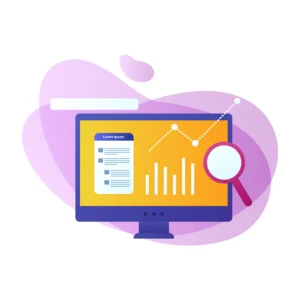Digital marketing is all about using digital channels, platforms, and technologies to promote products or services to a specific group of people. Unlike traditional marketing methods like print or TV, digital marketing takes advantage of the internet’s vast and ever-changing landscape. It includes a wide range of online activities such as websites, social media, email, search engines, and other digital channels. The main goal of digital marketing is to connect businesses with their audience in the digital world. It involves various strategies and tactics like content marketing, social media marketing, SEO, email marketing, and online advertising.
These methods aim to reach potential customers where they spend most of their time – online. Digital marketing is so popular because it offers a more targeted and measurable approach compared to traditional marketing. With the help of tools and analytics, businesses can track the performance of their campaigns in real time. They can gain insights into user behaviour, preferences, and the overall effectiveness of their marketing efforts. This data-driven approach allows businesses to optimize their strategies and make sure they are reaching the right audience with the right message.
Why Digital Marketing
Digital marketing holds immense importance in today’s business landscape due to the transformative impact of the digital era. Here are key reasons highlighting the significance of digital marketing:
- Global Reach: Digital marketing allows businesses to reach a global audience. Through online channels such as social media, websites, and search engines, businesses can connect with people around the world, breaking down geographical barriers.
- Cost-Effectiveness: Compared to traditional marketing methods like TV or print advertising, digital marketing often offers more cost-effective solutions. Small and medium-sized businesses can compete with larger counterparts on a more level playing field through targeted online strategies.
- Measurable Results: Digital marketing provides a wealth of data and analytics tools that enable businesses to measure the effectiveness of their campaigns in real time. Metrics such as website traffic, conversion rates, and customer engagement can be tracked, allowing for continuous optimization of marketing strategies.
- Targeted Advertising: With digital marketing, businesses can precisely target their audience based on demographics, interests, behavior, and more. This ensures that marketing efforts are directed at the right people, increasing the likelihood of conversion.
- Interactivity and Engagement: Digital marketing allows for interactive and engaging campaigns. Social media platforms, for example, provide a space for direct communication between businesses and their audience, fostering relationships and brand loyalty.
- Personalization: Through data analysis, businesses can tailor their marketing messages to specific segments of their audience. Personalized content increases relevance, making it more likely that customers will engage with and respond positively to marketing efforts.
- Adaptability and Flexibility: The digital landscape is dynamic, and digital marketing allows for quick adaptation to changes. Campaigns can be adjusted in real time based on performance metrics and market trends, ensuring a more responsive and agile marketing approach.
- Improved Conversion Rates: Digital marketing strategies, such as search engine optimization (SEO) and content marketing, are designed to attract and nurture leads. By providing valuable and relevant content, businesses can increase the likelihood of converting potential customers into actual ones.
- Enhanced Customer Experience: Digital marketing contributes to a positive customer experience by providing valuable, easily accessible information and support through various online channels. This contributes to customer satisfaction and loyalty.
- Competitive Advantage: Businesses that embrace digital marketing gain a competitive edge. Those not leveraging online channels may miss out on opportunities to connect with their target audience and may struggle to keep up with competitors who have a strong digital presence.
In summary, the importance of digital marketing lies in its ability to facilitate global reach, deliver cost-effective solutions, provide measurable results, and adapt to the evolving digital landscape, ultimately contributing to business growth and success in the digital age.

Types of Internet Marketing
Digital marketing encompasses various strategies and channels. Here are explanations of some key types:
Search Engine Optimization (SEO)
- What: Optimizing online content to rank higher in search engine results. Basically, we do On-Page SEO and Off-Page SEO.
- Why: Increases visibility, attracts organic traffic, and improves website ranking.
Search Engine Marketing (SEM) / Pay-Per-Click (PPC)
- What: Paid advertising to appear in search engine results.
- Why: Drives targeted traffic, provides quick results, and allows budget control.
Social Media Marketing
- What: Promoting products or services on social media platforms.
- Why: Enhances brand awareness, engages with the audience, and drives website traffic.
Content Marketing
- What: Creating and sharing valuable content to attract and retain the audience.
- Why: Builds trust, establishes authority, and supports other marketing efforts.
Email Marketing
- What: Sending targeted messages to a group of people via email.
- Why: Builds relationships, nurtures leads, and encourages customer loyalty.
Affiliate Marketing
- What: Partnering with affiliates to promote products for a commission.
- Why: Expands reach, leverages others’ audiences, and drives sales.
Influencer Marketing
- What: Collaborating with influencers to promote products or services.
- Why: Leverages influencers’ credibility, builds trust, and reaches specific audiences.
Video Marketing
- What: Using videos to promote and market products or services.
- Why: Captures attention, improves engagement, and conveys information effectively.
Mobile Marketing
- What: Targeting audiences on mobile devices through apps, websites, or SMS.
- Why: Reaches users on the go, capitalizes on mobile trends, and enhances user experience.
Remarketing/Retargeting
- What: Showing targeted ads to users who previously interacted with your site.
- Why: Encourages repeat visits, increases brand recall, and boosts conversion rates.
Interactive Marketing
- What: Engaging customers through interactive content or experiences.
- Why: Enhances user participation, fosters connection, and increases brand loyalty.
These digital marketing types often work together in an integrated strategy, offering businesses a versatile toolkit to connect with their audience, increase brand visibility, and drive desired actions online.
How can we do Digital Marketing?
-
Understanding Your Audience:
To effectively execute a digital marketing strategy, start by understanding your audience. Define your target demographic, delve into their interests, and analyze their online behaviour. Develop detailed buyer personas that represent your ideal customers, enabling you to tailor your marketing efforts more precisely.
-
Creating a Website:
Establishing a strong online presence begins with creating a website. Choose a domain name that resonates with your brand and design a user-friendly site that ensures easy navigation, mobile responsiveness, and a clear call-to-action. Your website serves as the central hub for your digital marketing activities.
-
Optimizing for Search Engines (SEO):
Enhance your online visibility through search engine optimization (SEO). Conduct thorough keyword research, optimize on-page elements such as meta tags and content, and consistently produce high-quality, relevant content. A well-optimized website increases the likelihood of appearing in search engine results, driving organic traffic.
-
Using Social Media:
Leverage the power of social media platforms to connect with your audience. Choose the platforms most relevant to your target demographic and share a mix of promotional and engaging content. Actively engage with your audience by responding to comments and messages, fostering a sense of community around your brand.
-
Email Marketing:
Build and nurture relationships with your audience through email marketing. Encourage website visitors to subscribe, segment your email list based on user behavior or demographics, and personalize your email content. Email marketing is a powerful tool for delivering targeted messages and keeping your audience informed.
-
Content Marketing:
Develop a comprehensive content marketing strategy to provide value to your audience. Regularly publish informative blog posts, create visually appealing content, and share content across various channels. A strong content marketing strategy establishes your brand as an authority in your industry.
-
Paid Advertising (SEM/PPC):
Gain quick visibility through paid advertising on search engines and social media. Select relevant keywords, craft compelling ad copy and visuals, and set a budget to manage your advertising spending effectively. Paid advertising supplements organic efforts and helps reach a broader audience.
-
Affiliate Marketing:
Expand your reach by establishing an affiliate marketing program. Clearly define terms for affiliates, implement tracking systems to monitor affiliate-driven sales, and provide commissions for successful referrals. Affiliate marketing is a collaborative approach to extending your brand’s reach.
-
Influencer Marketing:
Collaborate with influencers to leverage their audience and credibility. Identify influencers aligned with your brand, negotiate collaboration terms, and tap into their follower base to amplify your message. Influencer marketing builds trust and expands your brand’s reach.
-
Video Marketing:
Engage your audience with compelling video content. Develop a video content strategy, tailor videos for specific platforms, and harness the power of visual storytelling to convey your brand message effectively. Video marketing is a versatile tool for capturing attention and increasing engagement.
-
Mobile Optimization:
With the increasing use of mobile devices, ensure your digital assets are optimized for mobile users. Implement responsive design for your website, and consider developing a mobile app if it aligns with your business goals. Mobile optimization enhances the user experience for on-the-go audiences.
-
Analytics and Monitoring:
Utilize analytics tools to track and measure the performance of your digital marketing campaigns. Regularly generate reports to assess key metrics and make data-driven decisions. Monitoring campaign analytics allows for continuous optimization and improvement.
-
Remarketing/Retargeting:
Implement remarketing or retargeting strategies to re-engage users who have interacted with your website. Place tracking pixels on your site, segment your audience based on behavior and create targeted ads to bring visitors back to your site, increasing the chances of conversion.
-
Interactive Content:
Enhance user engagement with interactive content. Experiment with quizzes, polls, or interactive videos to encourage active participation. Interactive content not only captures attention but also fosters a deeper connection with your audience.
-
Staying Updated:
Digital marketing is dynamic, and staying informed about industry trends is crucial. Engage in continuous learning, adapt your strategies based on emerging trends, and remain flexible in your approach. Staying updated ensures that your digital marketing efforts align with current best practices and consumer preferences.

Conclusion-
To sum up, becoming proficient in digital marketing requires a well-rounded and strategic approach. It all starts with understanding your target audience, which forms the basis for creating customized strategies that resonate with potential customers. A user-friendly website acts as the central hub, optimized to improve visibility on search engines. Social media, email marketing, content creation, and paid advertising help expand your reach and engage with your audience. Collaborating with affiliates and influencers allows you to tap into external networks. Video content and mobile optimization cater to the changing preferences of consumers.
Analytics and monitoring provide valuable insights that guide continuous improvement. Re-marketing strategies and interactive content help re-engage and captivate your audience. In this ever-changing digital landscape, staying updated is crucial. Digital marketing is not a one-size-fits-all solution; it’s an ongoing process of adaptation, creativity, and data-driven refinement that ensures a brand’s relevance and success in the digital realm.







